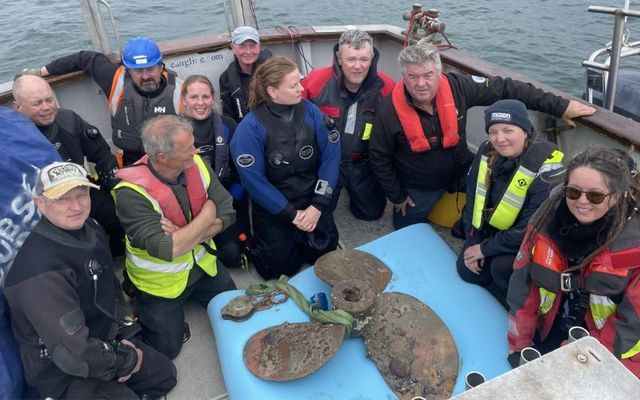A team of divers have recovered the propeller of a German Submarine that sunk in Cork Harbour during the First World War in 1917.
The UC-42 German submarine sank off Roches Point in the mouth of Cork Harbour on September 10, 1917, when a mine it was carrying exploded, killing all 27 sailors on board.
The submarine's location was discovered by local divers in 2010 and has since been declared a war grave under the National Monuments Act.
Cork diver Timmy Carey of the Blackwater Sub Aqua Club discovered the location of the propeller around two years ago, around 15 meters from the submarine wreck.
Carey initiated a plan to safeguard the relic against trawling and salvage, stating that Monday's recovery operation highlighted how authorities can work together to "successfully recover vulnerable materials from wreck sites like the UC-42 submarine."
Blackwater Sub Aqua Club and Mizen Archaeology carried out the recovery operation with the support of the National Monuments Service, the National Museum of Ireland, and the Federal Republic of Germany through their embassy.
A team of six divers assessed, recorded and excavated the propeller over the course of several months before finally recovering the artifact on Monday afternoon, June 17.
The propeller was raised from a depth of 30 meters below the surface and taken to Kinsale Harbour on board the MV Harpy, with conservation work set to begin immediately.
Conservation teams will "confirm, or otherwise" whether the propeller belonged to the UC-42 before the artifact goes on display on Spike Island.
Julianna O'Donoghue, an underwater archaeologist with Mizen Archaeology, told RTÉ News that she expects the propeller will contain markings that will "further our understanding of the site, and confirm, or otherwise if it is associated with the UC-42 wreck."
Minister for Heritage Malcolm Noonan welcomed the recovery of the propeller and said the UC-42 is a "significant part" of Ireland's underwater heritage.
"The UC-42 wreck is a significant part of our underwater cultural heritage and the final resting place of the German crew who were on board. It remains incumbent on us all to ensure we respect their remains," Noonan said in a statement.

Love Irish history? Share your favorite stories with other history buffs in the IrishCentral History Facebook group.
German Ambassador to Ireland Cord Meier-Lkodt said he hoped the conservation work will allow the propeller to go on display.
"This will encourage more engagement with and learning about both German and Irish wartime history," Meier-Lkodt said in a statement.
In November 1917, an oil slick alerted British authorities to the sinking of the UC-42.
Divers sent to investigate by the British Navy discovered that the submarine's mine shoot was empty and that its stern had been completely destroyed, indicating that a mine had detonated prematurely.
Divers additionally observed that the submarine's hatches were open, indicating that the crew attempted to escape following the explosion. They recovered the submarine's periscope and documents as evidence and the wreck remained undiscovered for 93 years before it was re-discovered by the Blackwater Sub Aqua Club.
German submarines regularly dropped mines in Cork Harbour during the First World War in a bid to damage or destroy British ships.




Comments